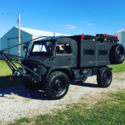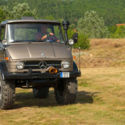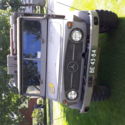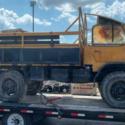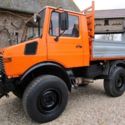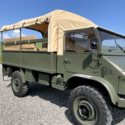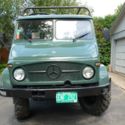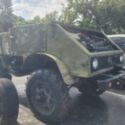Mercedes Unimog 406 custom
| Make: | Mercedes-Benz |
| Model: | 406 |
| Year: | 1978 |
| Mileage: | 500 |
| VIN: | 40612110030392 |
| Color: | Black |
| Cylinders: | 6 |
| Fuel: | Diesel |
| Drive type: | 4WD |
| Interior color: | Black |
| Vehicle Title: | Clear |
| Item location: | Dania, Florida, United States |
1978 Mercedes-Benz 406 Additional Info:
Breathless Racing Dakar Style Unimog 406
Build Cost 95,000.00
Selling 55,000.00
One of a kind custom built by Breathless Racing Team Unimog
Built by our company as a ultimate truck for maximum exposure for companies or that special person that wants a unique of of a kind build
Take her our for a cruise to your local cars and coffee event or park it in front of your company to draw in attention
1978 Mercedes Unimog 406
1350 hrs less than 500 miles
Top speed approximate 55-60 mph
Custom cab design
Insolated cabin
Headliner
Full interior carpet
Custom 3 row seating
Custom Side door
Leather bucket seats
12 volt roof air condition system
Custom interior lighting
Custom sound bar with blue tooth and FM stations
Dekar style roof rack and spare tire
Small pickup bed with diamond plate
Dual Exhaust stacks
Built in battery charging system
110v power interior
LED auxiliary headlights
LED Tail lights
Custom front and rear bumper
Michelin XZL 395/85/20 50” tall tires
6 cylinder Mercedes diesel OM352
8 speed manual transmission
PTO
Special option torque converter
Start and stop in any gear without pressing the clutch
4 wheel drive with locking differential
Disk Brakes
For more info 954658eighttwotwoeight
Info on the 406 is below:
The Unimog 406 is an all-wheel drive truck made by Mercedes-Benz made from 1963 to 1989. It is part of the Unimog (Universal-Motor-Gerät) series that originated in the 1940s. A total of 37,069 units of the 406 were manufactured at Daimler-Benz AG's Mercedes-Benz-Werk Gaggenau[2] and also made in Argentina in the plant of Virrey del Pino, Buenos Aires[3] since 1968 to 1976. It was the first medium duty Unimog, having a larger wheelbase of 2,380mm (94in) and more than twice the engine power of the Unimog 401. Unlike the initial Unimog, the 406 does not have a car engine but a high capacity[clarification needed] truck engine.[4] Several later Unimog versions were based on the 406. The 406 were made in 12 versions, including a closed-top two-door or four-door cab, an open-top Cabrio, and as a "half" Unimog OEM part of third-party vehicles, such as a road–rail vehicle capable of towing 300t (300 long tons; 330 short tons).[5][2] During its production period, the 406 received several technical refinements. In 1964, the precombustion chamber diesel engine OM 312 was replaced with the direct injected OM 352. Disc brakes followed in 1973
The Unimog 406 is a small multi-purpose off-road capable vehicle with four wheels of the same size. Like other Unimogs, it has a ladder frame, two portal axles with reduction gears and coil springs with hydraulic shock absorbers for the rear and front axle. For powering mountable equipment, two standard switchable 540/1000rpm PTOs are built in; both can be switched on and off independently. The 406 is a rear-wheel-drive vehicle with switchable all-wheel-drive and an additional differential lock. A flatbed was mounted on the rear part of the Unimog frame.
Initially, the water-cooled straight-six precombustion chamber diesel engine type OM312 powered the Unimog 406. It has a displacement of 4,580cc (279cuin) and produces roughly 48kW @ 2,550rpm.[2] In 1964, this engine was replaced with the direct injected straight-six diesel OM352 that was kept in production until 1989. The OM 352 displaces 5,675cc (346.3cuin) and is naturally aspirated in the Unimog version, its power output figure was changed over the production period several times, however, the standard power output never exceeded 62 kW.[5] The air-inlet is on the left hand side of the Unimog 406, a snorkel was a factory option. Depending on the gearbox, the Unimog 406 was equipped either with a single disc dry clutch (usually type G 280 KR) or a dual clutch.
Each wheel of the 406 has a pneumatic-hydraulic servo drum brake; starting in 1973, disc brakes were used instead. Unimogs for export markets were still offered with drum brakes until 1989.[1][bettersourceneeded] The standard power-steering system is a worm-and-nut steering type ZF 7419, a ball-and-nut steering was offered optionally.[6] The standard tyres have the size 10.5–20", Daimler-Benz also offered 12.5–20"-tyres as a factory option.[5] Unlike the initial Unimog, the 406 has two 12 V lead acid batteries and a 24 V electric system.
GearboxThe 406 has the fully synchronised four-speed UG-2/27 group-gearbox that is designed for a maximum input torque of 27 kp·m (264.8 N·m). It was available with four different gearbox layouts:
The default gearbox layout has four gears and two groups. The first group however only allows the first and second gear to be engaged so that the total amount of gears is six; the gearbox lever has a six-speed H-layout. When shifting from second into third gear, the gearbox automatically switches from the first into the second group. The gearbox lacks a reverse gear, instead, the Unimog has a second gear lever for switching the driving direction. This lever is part of an additional reverse gear unit. When in reverse, due to the gearbox construction, only the first group of the gearbox, that can make use of the first two gears only, can be used. This results in two reverse gears.[7]
The standard gearbox was also available with an additional intermediate gearbox. The intermediate gearbox simply doubles the amount of gears, resulting in 2 × 6 forward and 2 × 2 reverse gears. Its gear lever has the three positions ″main gearbox″, ″intermediate gearbox″ and neutral. In addition to the additional intermediate gearbox, Daimler-Benz also offered a crawler-gearbox. The crawler-gearbox can be used with the first and second gear of every group of the main gearbox, it has two crawler gears, ″crawler″ and ″super crawler″, a neutral position and a ″main gearbox″ position. When in main gearbox position, all main gearbox gears can be used. This results in 2 × 6 + 2 × 4 forward and 2 × 2 + 2 × 2 reverse gears.[7]
Later, the default gearbox was also available with a fully usable first gear group, resulting in eight forward gears and four reverse gears. The eight-speed-gearbox-lever has a single-H-layout with an additional lever for switching the groups, rather than the six-speed-H-layout.[7]
The initial factory power output of the naturally aspirated OM 352 engine was 93 kW with a maximum torque of 353 N·m, this figure was later increased to 96kW (129hp). The Unimog however received a significantly power reduced engine version. Daimler-Benz never offered the standard and high power output versions for the Unimog 406, since its gearbox and clutch are designed for an input torque of only 27 kp·m (264.8 N·m). For increasing the engine power of the Unimog 406 to 96 kW, the gearbox and clutch have to be replaced first. The engine itself usually needs a paper air filter instead of the oil bath air cleaner, a new oil filter and a modified injection pump because the built in injection pump cannot be set to 96 kW.[8]













